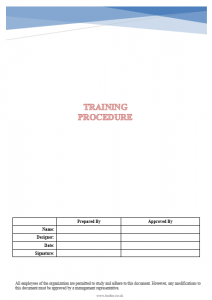Training Procedure
The training procedure serves as a comprehensive guide for identifying necessary training initiatives and their implementation within the organization. The primary objective of conducting training sessions is to enhance the awareness and competence levels of the organization’s employees.
Is training in ISO 9001 a requirement?
Employee training is not explicitly mandated by the ISO 9001:2015 standard. However, it is considered a vital aspect that organizations must adhere to in order to attain the requisite competence and evaluate the effectiveness of their actions.
Necessary Action By Organizations
The Purpose of the Training Procedure
The purpose of preparing and compiling this Procedure is to elucidate the process of identifying training needs and establishing methods to conduct and oversee company activities, thereby enhancing employees’ competence and awareness.
The Scope of the Training Procedure
The implementation of this Training Procedure encompasses all employees of the company.
Responsibility and Authority in Training Procedure
The responsibility for identifying training needs lies with the managers and supervisors of the respective departments, who communicate these needs to the designated training authority. Approval of the training is the responsibility of the factory or CEO management.

Why is training important in an organization?
Free download of the training procedure.
|
Training Procedure
|
ISO 9001:2015 Requirements
7.2 Competence
| The organization shall : a) determine the necessary competence of person(s) doing work under its control that affects the performance and effectiveness of the quality management system; b) ensure that these persons are competent based on appropriate education, training, or experience; c) where applicable, take actions to acquire the necessary competence, and evaluate the effectiveness of the actions taken; d) retain appropriate documented information as evidence of competence. |
| NOTE Applicable actions can include, for example, the provision of training to, the mentoring of, or the re-assignment of currently employed persons; or the hiring or contracting of competent persons. |
7.3 Awareness
| The organization shall ensure that persons doing work under the organization’s control are aware of: a) the quality policy; b) relevant quality objectives; c) their contribution to the effectiveness of the quality management system, including the benefits of improved performance; d) the implications of not conforming to the quality management system requirement |


